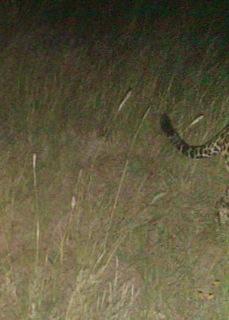
TUCSON, Ariz. - The Arizona Game and Fish
Department is currently analyzing a recent trail camera photo of either a
jaguar or an ocelot sighted southeast of Tucson.
The photo includes only the tail and a small portion of a hind quarter of the
animal, making positive identification more difficult. Game and Fish is now
consulting with outside experts about the photo, taken Sept. 23 and submitted
by a sportsman, to better identify the species.
"We have definitively determined that it is either a jaguar or an ocelot,
but we need to do further analysis of the animal's spot patterns and size to
try to positively identify which species it is," said Game and Fish
Nongame Branch Chief Eric Gardner.
Four of the last five confirmed jaguar sightings in Arizona have been reported
by hunters, who all took responsible action to document the animal and report
it to Game and Fish. Sportsmen also provided Game and Fish with two sets of
trail camera photos of an ocelot in the Huachuca Mountains in 2012. These
hunters have provided biologists with critical information that may not
otherwise be known, information that will help increase the understanding of
these species' existence in the borderland area.
Jaguars have been protected outside of the United States under the Endangered
Species Act since 1973. That protection was extended to jaguars within the U.S.
in 1997, the year after their presence in the Arizona and New Mexico
borderlands was confirmed.
Jaguars once ranged from southern South America through Central America and
Mexico and into the southern United States. It is believed that southern
Arizona is the most northern part of the range for a population of jaguars
living in Sonora, Mexico.
Ocelots are small to medium-sized spotted cats with a long tail. These cats
have been listed as endangered since 1982 under the federal Endangered Species
Act.
The present range for ocelots is in the eastern and western lowlands of Mexico,
from southern Mexico through Central America and in the lowland areas of
Colombia, Ecuador, Peru and Brazil. On the fringes of their range, they occupy
a very limited region in both the United States (a remnant population exists in
southern Texas) and Argentina. Other animals such as bobcats, young mountain
lions and servals, an African cat popular in the pet
trade, are sometimes misidentified as ocelots, which is why verification is so
very important.
Jaguars and ocelots are protected by the Endangered Species Act and should be
left alone. If anyone encounters a cat believed to be a jaguar or ocelot, the
Game and Fish Department requests that photos along with observation
information be reported immediately to the department or through the Operation
Game Thief hotline at (800) 352-0700.


 Advertising
Advertising